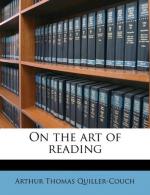My second reason is that the poem, being brief, compendious and quite simple in structure, can be handily expounded; “Job” is what Milton precisely called it, ‘a brief model.’ And my third reason (which I must not hide) is that two writers whom I mentioned in my last lecture Lord Latymer and Professor R. G. Moulton—have already done this for me. A man who drives at practice must use the tools other men have made, so he use them with due acknowledgment; and this acknowledgment I pay by referring you to Book II of Lord Latymer’s “The Poet’s Charter,’ and to the analysis of “Job” with which Professor Moulton introduces his “Literary Study of the Bible.’
II
But I have a fourth reason, out of which I might make an apparent fifth by presenting it to you in two different ways. Those elders of you who have followed certain earlier lectures ’On the Art of Writing’ may remember that they set very little store upon metre as a dividing line between poetry and prose, and no store at all upon rhyme. I am tempted to-day to go farther, and to maintain that, the larger, the sublimer, your subject is, the more impertinent rhyme becomes to it: and that this impertinence increases in a sort of geometrical progression as you advance from monosyllabic to dissyllabic and on to trisyllabic rhyme. Let me put this by a series of examples.
We start with no rhyme at all:
Hail, holy Light, offspring
of Heaven first born!
Or of the Eternal coeternal
beam
May I express thee unblamed?
since God is light,
And never but in unapproached
light
Dwelt from eternity.
We feel of this, as we feel of a great passage in “Hamlet” or “Lear,” that here is verse at once capable of the highest sublimity and capable of sustaining its theme, of lifting and lowering it at will, with endless resource in the slide and pause of the caesura, to carry it on and on. We feel it to be adequate, too, for quite plain straightforward narrative, as in this passage from “Balder Dead”:
But from the hill of
Lidskialf Odin rose,
The throne, from which
his eye surveys the world;
And mounted Sleipner,
and in darkness rode
To Asgard. And
the stars came out in heaven,
High over Asgard, to
light home the King.
But fiercely Odin gallop’d,
moved in heart;
And swift to Asgard,
to the gate, he came.
And terribly the hoofs
of Sleipner rang
Along the flinty floor
of Asgard streets,
And the Gods trembled
on their golden beds—
Hearing the wrathful
Father coming home—
For dread, for like
a whirlwind, Odin came.
And to Valhalla’s
gate he rode, and left
Sleipner; and Sleipner
went to his own stall:
And in Valhalla Odin
laid him down.




